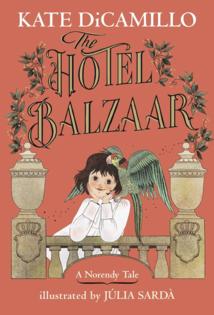Kate DiCamillo wrote the book she needed -- about connection and love
Published in Books News
MINNEAPOLIS — Kate DiCamillo was walking down a south Minneapolis street when she realized she had to write “The Hotel Balzaar.”
It was in the early days of the pandemic, when we still hoped it was a short-term thing, but were all staying 6 feet apart. DiCamillo— a walker, as much as she’s a reader and a writer — was giving others a wide berth.
“This was back when we started to think you shouldn’t pass somebody on the sidewalk. You should give each other the whole side,” recalled DiCamillo, author of “Because of Winn-Dixie,” “Flora & Ulysses” and many more.
“I was on Harriet Avenue, in the middle of the street near Judson Church,” she said. “I was kind of halfway down that block and stopped. There were people on either sidewalk, so I just took the middle of the street.”
With the world looking grim, her mind turned — as it often does — to the importance of stories.
“I thought, ‘What do I need? I need a fairy tale,’ ” said DiCamillo. “The next morning, I started on ‘Balzaar.’”
A bright side of that time was that DiCamillo, stuck at home, worked a lot. “The Hotel Balzaar,” in which a lonely girl named Marta befriends an eccentric countess who lives in the same hotel and who regales Marta with wild tales, is her third book this year. It takes place in the fictional land of Norendy, which first appeared in last year’s“The Puppets of Spelhorst.”
DiCamillo talked with the Minnesota Star Tribune about the origins of her latest book, as well as her love of Wes Anderson films, which of her characters she’d like to live with, how telling stories staves off evil and the kind of friendship that pops up often in her books.
Q: You’ve said “Balzaar” had a lot to do with the pandemic?
A: I think you can feel that in there. It’s that suspended waiting and that need for connection and need to believe. One thing that was in my head, off to the side, was Isak Dinesen. Her very self and then also “Seven Gothic Tales.” And I did have “The Grand Budapest Hotel” in my head a little bit.
Q: My favorite Wes Anderson movie!
A: Mine, too! I didn’t become a really, really big fan until “Moonrise Kingdom.” There are other Wes Andersons that people love more but that’s where I got on board. Those visuals, combined with Benjamin Britten’s music. And then where I totally lost it was “Grand Budapest.”
Q: I’ve sometimes heard the question, “If you could live inside a painting, which would you choose?,” which I thought of because paintings figure into “Balzaar.” But that made me wonder, if you could move into one of the worlds you created in your books, which would it be?
A: Well, first I want to answer the painting question. I’ve never heard that before and I love it. Every morning after I write I go back downstairs and do journaling and read some poetry and also look at the Phaidon book of art, they make it in a coffee-table size and a hand-held size. I’ve recently fallen in love with a Danish artist named Vilhelm Hammershoi, so I’d like to live in one of his works.
Q: OK, which book?
A: I want to live on Deckawoo Drive [the rowdy setting of seven DiCamillo books, including last year’s “Mercy Watson is Missing”]. That’s ultimately who I am. I have no dignity, in a way. I’ve always thought the ideal job for me would be if I could have written for Looney Tunes. Although, actually, where I really want to live is with the Brown family and Paddington Bear.
Q: This is the second tale in the land of Norendy, and another is coming next year. Did you know from the beginning it would return to the world of “Puppets of Spelhorst”?
A: It all came after the fact. But I knew it would be the same length. It’s going to be another fairy-tale novella. And that’s when Candlewick [her publisher] and my editor said, “Let’s have these be in a magical place that’s here and not there, that is this world but only if you squint.”
Q: The book is filled with beautiful illustrations by Júlia Sardà. Do they inform your storytelling or do they come later?
A: The text is done and then the Candlewick design person and my editor work together to figure out who’s going to do the art and they work with her and I see the art as it comes in and I’ve never been so utterly gobstopped by it. All I could say was, “Yes, yes, yes.” As to what it does for the story, as I said, it’s like the prose becomes a launching pad. The story still exists without the art but it’s like this art lifts off into the stratosphere, using the text.
Q: With the countess telling her tales to Marta, tales that become increasingly important to both of them, I kept thinking of that Joan Didion quotation about how we tell each other stories to survive. You know the one I mean?
A: Yes. There’s also a quote that makes me think of, which I think is Carl Jung and I won’t get it right but I’ll get the gist of it: Evil exists because people don’t get to tell their stories [”The reason for evil in the world is that people are not able to tell their stories.”]. Yes, we’re telling stories to survive. Yes. For me, personally, that is so explicitly what was going on as I wrote this book. It was that moment of walking — it was March of 2020 and it was like, “I’m not going to get through this unless I have a fairy tale to write.” I’m telling this story to survive and that is true within the confines of the story as well. It’s true of the countess, it’s true of Marta, it’s true of Blitzkoff [the countess’ parrot].
Q: And the idea is that storytelling is a way to show empathy?
A: Empathy and thinking. If you have those things, anything is possible if you’re willing to sit with somebody. We tell each other stories to feel seen. It’s like, “This is who I am,” and, as I write these stories, “This is who I can become.” That’s what books do for me, again and again. They show me I can change, that I can become a different person, that I can occupy the world in a different way.
Q:“Balzaar” is dedicated to Heller Landecker, a Minneapolis therapist. When I went to her website and saw her credo, “I believe people carry the answers they seek inside them,” I thought, “That could almost be a DiCamillo character’s motto.”
A: That’s so true. And it also sounds kind of Jungian. Heller is one of my dearest friends, one of my first readers, and she’s also a brilliant editor. She is somebody who can stand back and see the whole truth of the thing.
Q: In some ways, talking to each other, the countess and Marta are in a kind of talk therapy.
A: If you look at a lot of my stories, that intergenerational thing is there: somebody very young and somebody very old and they’re both in need. Yes, the countess helps Marta but Marta helps the countess, too. It makes me think of that Cloris Leachman quote about how every nursing home should have an orphanage next to it. We don’t tap into that enough in this society. I would have to think of how many times it shows up in my work. It’s on Deckawoo Drive and in “Because of Winn-Dixie” and“Raymie Nightingale” and “Ferris” and in here, too. They both feel seen and that becomes a magical thing, to feel seen.
Q: That’s interesting. There’s no overt magic in the book but it does feel magical in that way.
A: When Ann [novelist Ann Patchett, DiCamillo’s friend] read this, she said it was utterly magical. And I said, “OK, don’t say anything else.” I don’t want a lot of deep criticism at the point where the first readers read because it can derail me. I want to know if it seems real.
Q: How do readers fit into that equation? You’ll take lots of questions at Talking Volumes, and you’ve said you love that part of readings. What are you hoping for at live events?
A: What I hope for when people ask me questions is just that thing where we’re in it together and I get to see the story from a different viewpoint, based on the question. It helps me understand it more. So, what’s the question I like the best? The question that helps me connect to people and see the story that we’re both in.
©2024 The Minnesota Star Tribune. Visit at startribune.com. Distributed by Tribune Content Agency, LLC.
















Comments